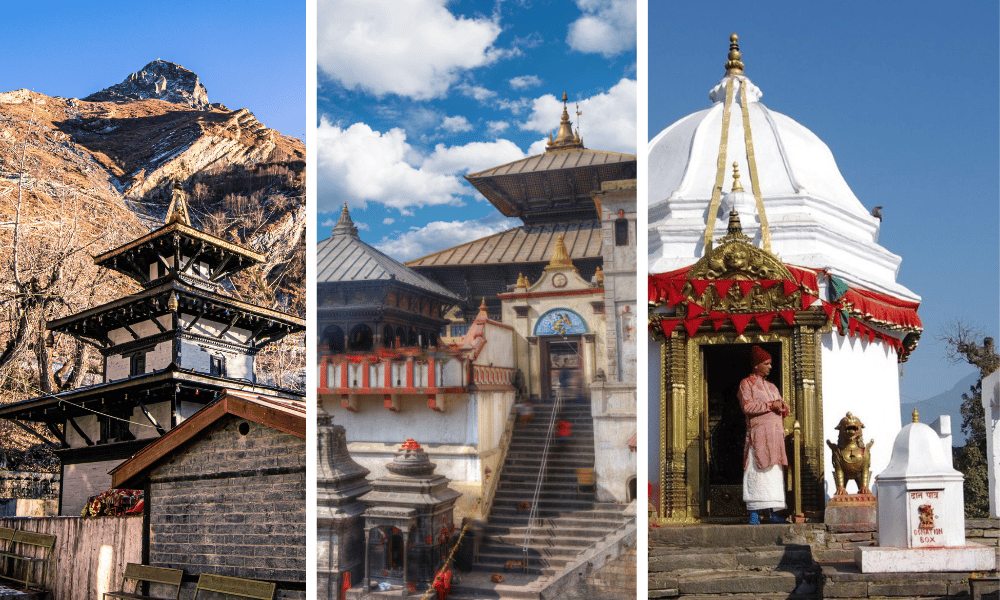Nepal's temples are the heart and soul of the country, weaving together a tapestry of faith, culture, and history. These temples, nestled among the breathtaking Himalayan scenery, symbolize the unique coexistence of Hinduism and Buddhism, with complex pagoda-style architecture covered with delicate woodwork and vibrant artwork. Kathmandu Valley, a UNESCO World Heritage Site, is home to iconic temples such as the Pashupatinath Temple and Changunarayan Temple, which attract pilgrims and visitors from all over the world.
During festivals, these holy places spring to life and present a striking exhibition of devotion and cultural legacy. Temples are filled with worshipers, colorful rituals, and the rhythmic beats of traditional music and dance during festivals like Dashain and Tihar. In addition to their religious significance, these temples serve as sanctuaries for spiritual seekers and practitioners, providing a place of peacefulness in the midst of daily life.
However, these architectural marvels encounter obstacles, such as natural disasters and the passage of time. Efforts are being made to protect Nepal's temple heritage and make sure that these symbols of faith and culture continue to inspire and enrich the lives of people for years to come. The temples of Nepal are more than just places of worship; they are also active reminders of the country's rich spiritual heritage, luring tourists to come and explore its entrancing beauty and depth.
The following is a list of some of the most well-known Hindu temples in all of Nepal:
List of 12 Must visit Temples in Nepal
|
Name of the Temples |
Location |
|
Pashupatinath Temple |
Gaushala, Kathmandu |
|
Janaki Temple |
Janakpur, Dhanusa |
|
Guhyeshwari Temple |
Gaushala, Kathmandu |
|
Shesh Narayan Temple |
Dakshinkali, Kathmandu |
|
Dakshinkali Temple |
Pharping, Kathmandu |
|
Patan Krishna Temple |
Patan, Lalitpur |
|
Doleshwor Mahadev Temple |
Suryabinayak, Bhaktapur |
|
Muktinath Temple |
Mustang, Nepal |
|
Changunarayan Temple |
Changunarayan, Bhaktapur |
|
Bindhyabasini Temple |
Pokhara, Kaski |
|
Manakamana Temple |
Kurintar, Gorkha |
|
Jal Narayan Temple |
Budhanilkantha, Kathmandu |
Pashupatinath Temple
The Pashupatinath temple, which is also regarded as Nepal's most important holy site and a sacred location for both Hindus and Buddhists, offers a variety of spiritual, cultural, and religious experiences. The main temple is built in the Nepali pagoda style of architecture. The two-level roofs are made of copper with a gold covering. The temple rests on a square base platform with a height of 23 meters and 7 centimeters from base to pinnacle. It has four main doors, all covered with silver sheets, and a gold pinnacle (peak). It is thought to be one of the holiest places where Lord Shiva, the destroyer and transformer of Hinduism's divine trinity, is worshipped. The exact date of Pashupatinath’s construction is unknown. Despite this fact, Pashupatinath is considered the oldest Hindu temple in Kathmandu. The earliest evidence of the temple’s existence dates back to 400 A.D. The current main temple of the Pashupatinath complex was built at the end of the 17th century to replace the previous one, destroyed by termites.
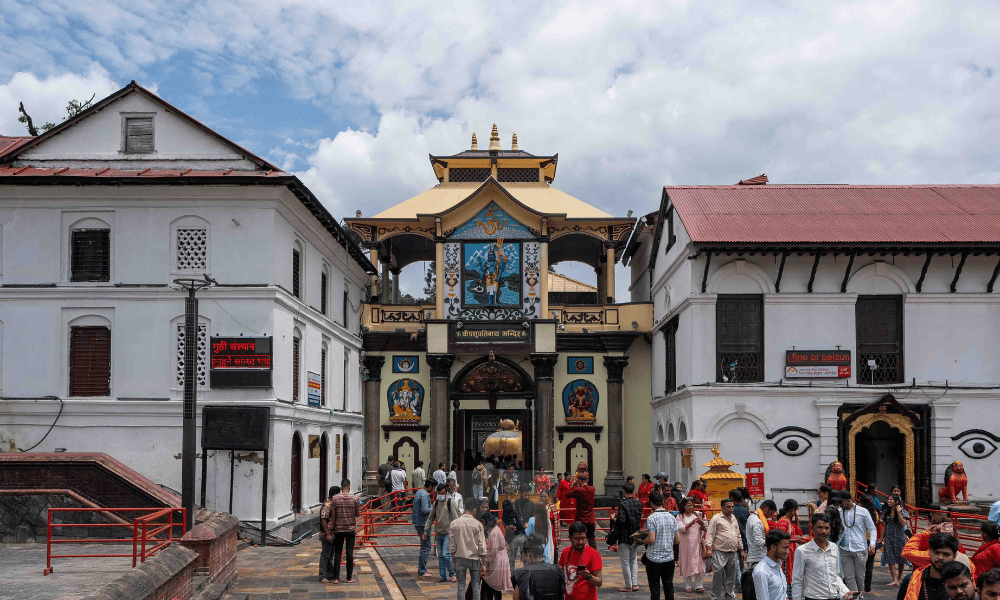
Located 4 kilometers northwest from the center of Kathmandu, it sits on the banks of the Bagmati River and is home to a number of religious sites. These include Deupatan, Jaya Bageshori, Gaurighat (Holy Bath), Kutumbahal, Gaushala, Pingalasthan, and Sleshmantak Forest. There are about 492 temples, 15 Shivalayas (sites of Lord Shiva), and 12 Jyotirlingas (phallic shrines) to visit. Additionally, the elevated platform along the Bagmati River is used as a cremation ground for Hindus. 'The aarti' (performance of holy ceremonies dedicated to god), performed by priests on the banks of the Bagmati River every evening, is also a remarkable spiritual experience at Pashupatinath Temple.
The Pashupatinath Temple is extremely important to Hindu worshipers all over the world. Sadhus and devotees from all over India and Nepal come to the temple to seek blessings, meditate, and soak up the spiritual atmosphere. Every year, thousands of pilgrims and tourists come to the temple's Maha Shivaratri festival to see big processions, religious ceremonies, and cultural shows. The temple complex is also a UNESCO World Heritage Site, which shows how important it is historically and culturally. Entry to the inner temple area is for Hindus only, but the rest of the complex is open to visitors. Visitors can also see the animals and monkeys that live in the forests around the temple. This makes Pashupatinath Temple a unique mix of spiritual and natural beauty that draws people in.
Read More: Pashupatinath Temple
Pashupatinath Temple Facts
|
Site |
Pashupatinath |
|
Affiliation |
Hinduism |
|
Deity |
Shiva |
|
Location |
Gaushala, Kathmandu |
|
Established by |
Prachanda Deva (believed) |
|
Number of Temples |
518 |
|
Major Attractions |
|
|
Major Celebrations |
|
|
Style |
|
|
Area |
264 hectares (652 acres) |
|
Opening Hours (main temple) |
04:00 AM–12:00 PM 05:00 PM–09:00 PM |
|
Entry Fee |
Free for Nepalese and Indians NRs. 1000 for others |
How to reach?
The easiest way to get to the Pashupatinath Temple is to travel through the closest cities.
From Kathmandu
It is a very simple and quick journey to get to Pashupatinath Temple from Kathmandu. It is 4 kilometers from Kathmandu's center, so getting there in one of the many cabs, taxis, or buses available will take about 20 minutes.
Janaki Temple
The Janaki Temple is a spectacular religious and architectural jewel located in the heart of Janakpur, a city in Nepal's southeastern region. The Hindu goddess Sita, who was also Lord Rama's wife, is honored in this temple. The mandir is also popularly known as the Nau Lakha Mandir (meaning "nine lakhs"). The cost for the construction of the temple was about the same amount of gold coins: nine lakhs or nine hundred thousand gold coins, hence the name. The temple dates back to ancient times, and it is thought that Queen Brisabhanu Kunwari of Tikamgarh started building it in the early 20th century. The temple's architecture, which combines Rajput and Mughal styles, is distinguished for its magnificent marble carvings. With its beauty and historical importance, it serves as a symbol of Nepal's rich cultural history and draws tourists. The environment surrounding the shrine is equally beautiful, with quiet gardens and ponds creating a peaceful ambience for both pilgrims and visitors.
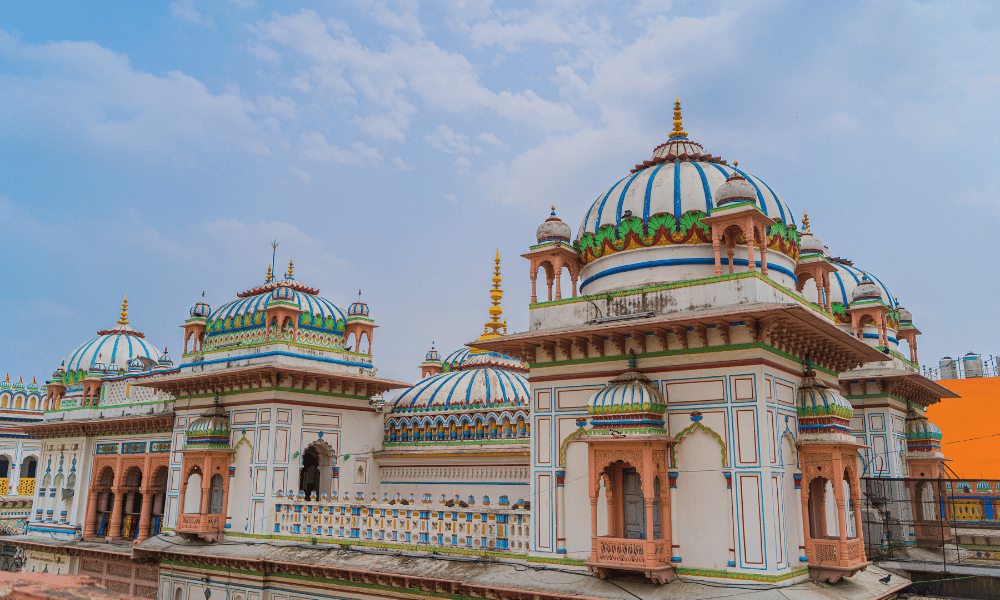
Hindus attach great religious value to the Janaki Temple. It is a cherished pilgrimage destination since it is thought to be the birthplace of the goddess Sita. Devotees visit the temple in large numbers to pay their respects and ask for blessings from all across India and Nepal. The divine idols of Goddess Sita and Lord Rama are housed in the sacred space of the temple, and each year, during the Vivah Panchami festival, a recreation of their wedding ceremony is performed to a huge crowd of worshippers. In addition to its significance as a place of worship, the temple also plays a significant role in the community's culture by holding a number of fairs, festivals, and other events. Janaki Temple is not only a place of worship but also a symbol of unity, tradition, and spirituality for all who visit.
Janaki Temple Facts
|
Site |
Janaki Temple |
|
Affiliation |
Hinduism |
|
Deity |
Janaki and Rama |
|
Location |
Janakpur, Dhanusa |
|
Established by |
Queen Vrisha Bhanu |
|
Number of Temples |
70 |
|
Major Attractions |
|
|
Major Celebrations |
|
|
Style |
Rajput and Mughal styles |
|
Area |
1,480 square meters (15,930 sq. feet) |
|
Opening Hours (main temple) |
5:30 AM - 11:00 AM 4:00 PM - 8:30 PM |
|
Entry Fee |
No Entry Fee |
How to reach?
For visitors wanting to visit Janaki Mandir, one viable route is to traverse nearby cities.
From Janakpur
To reach the Janaki Mandir from Janakpur, one can walk if they are in the central area or use local transportation options such as auto-rickshaws, or taxis. Bicycles and public buses are also available for getting to the temple. It's a well-known landmark in Janakpur, so asking locals for directions is a convenient way to find your way there.
Guhyeshwari Temple
Guhyeshwari Temple is a renowned Hindu temple located in Nepal's Kathmandu Valley. Guhyeshwari Temple, located about 1 km east of the famous Pashupatinath Temple, is an important part of Nepal's religious and cultural history. It is unknown for certain when this ancient temple was built, but it is believed to be one of the valley's oldest, with its origins possibly dating back to the 4th century. In the 17th century, King Pratap Malla renovated this temple. The temple's unique design is characterized by pagoda-style roofs, stone carvings, and beautiful woodwork. The neighboring Bagmati River and lush greenery provide a peaceful environment within the temple premises. The temple complex consists of a main shrine honoring Goddess Guhyeshwari and a number of smaller shrines that are all tucked away in a peaceful courtyard.

The Guhyeshwari Temple holds great religious significance for both Hindus and Buddhists. It is considered to be a Shakti Peetha, which is a place where parts of the goddess Sati's body fell after Lord Shiva's Tandava, the cosmic dance of destruction. Devotees visit the temple to pray to Goddess Guhyeswari for their well-being and to perform various rituals. The temple is a popular destination for both tourists and pilgrims due to its peaceful atmosphere, historical value, and complicated architecture. Also, the fact that it is close to the Pashupatinath Temple, which is another important religious spot in the area, makes it more appealing as a spiritual destination. Along with its religious and historical importance, the Guhyeshwari Temple is a symbol of Nepal's rich cultural and spiritual history. It draws people from all over the world.
Pashupatinath and Guhyeshwari are beautiful representations of Shiva and Shakti unity. Guhyeshwari is also known for its Tantrik rituals (the secret tradition of Hinduism). The temple is located on the banks of the River Bagmati and shows the divine's feminine side. People who want to get stronger are said to worship the Mother Goddess at this temple.
Guhyeshwari Temple Facts
|
Site |
Guhyeshwari Temple |
|
Affiliation |
Hinduism |
|
Deity |
Parvati (Guhyekali) |
|
Location |
Gaushala, Kathmandu |
|
Established by |
N/A |
|
Major Attractions |
|
|
Major Celebrations |
|
|
Style |
Pagoda style |
|
Opening Hours (main temple) |
4 AM - 11 PM |
|
Entry Fee |
No Entry Fee |
How to reach?
For those looking to reach Guhyeshwari Temple, a convenient approach is to pass through the nearby cities.
From Kathmandu
From Kathmandu, the journey to Guhyeshwari Temple is straightforward and brief. It is 4 kilometers from the center of Kathmandu, so it will take approximately 20 minutes to get there using one of the many available cabs, mini-buses, or buses.
Sheshnarayan Temple
The historic and culturally significant Sheshnarayan Temple of Pharping is located in the picturesque Nepalese town of Pharping, situated in the Kathmandu Valley. One of the four Narayana temples in the Kathmandu Valley, this temple has a long history and is regarded as one of the most important and sacred temples in the area. The other three temples are Bishanku Narayana, Icchangu Narayana, and Changu Narayana, which are located in the four cardinal directions of Kathmandu Valley and are thought to protect the valley's inhabitants. It is believed that these temples were constructed under the rule of Licchavi King Vishnugupta. With its detailed wood carvings and beautifully crafted pagoda-style roofs, the temple's design is a blend of traditional Nepali and Newar styles. The temple is decorated with beautiful sculptures and creative features that demonstrate the mastery of ancient artists.

In Nepalese culture and Hinduism, the Sheshnarayan Temple in Pharping is highly significant. It is believed that Lord Vishnu, the Hindu god of preservation, resides within this temple, and devotees come here to pay their respects to him. The temple complex has other shrines and prayer rooms for different gods, making it a spiritual oasis for worshipers. One of the temple's greatest attractions is a sacred pond believed to have healing abilities, where devotees take ritual baths. Throughout the year, the temple also hosts a number of religious events that draw large crowds of both devotees and tourists. The Sheshnarayan Temple is more than just a place of worship. It is also a great example of Nepal's rich architectural history and an excellent spot for those seeking inner peace and learning about the country's ancient traditions.
Sheshnarayan Temple Facts
|
Site |
Sheshnarayan |
|
Affiliation |
Hinduism |
|
Deity |
Vishnu |
|
Location |
Dakshinkali, Kathmandu |
|
Established by |
Licchavi King Vishnugupta |
|
Major Attractions |
|
|
Major Celebrations |
|
|
Style |
|
|
Opening Hours (main temple) |
24 hours |
|
Entry Fee |
No Entry Fee |
How to reach?
Traveling through the adjacent cities is a practical means of getting to Sheshnarayan Temple.
From Kathmandu
To reach the Sheshnarayan Temple in Pharping from Kathmandu, you can take a taxi, hire a car, or catch a bus bound for Pharping. Upon arrival in Pharping, the temple is easily accessible on foot, and you can ask locals for directions as it's a well-known landmark in the town.
Dakshinkali Temple
Dakshinkali Temple is a major Hindu temple located approximately 22 kilometers southwest of Kathmandu, Nepal. This temple is dedicated to the goddess Kali and is well-known for its unusual rituals and loyal devotees. The most well-known manifestation of Kali is Mother Dakshinkali, the benevolent mother who protects her devotees and children from mishaps and misfortunes. Those seeking blessings for protection and fulfillment of desires holds the temple in high regard. In honor of the ferocious deity Kali, it is traditional practice to sacrifice animals, most commonly male goats and chickens. The exquisite carvings and decorations around the temple are amazing, and the atmosphere is lively and colorful during festivals. Particularly during festivals like Dashain, people from all across Nepal pay a visit to the Dakshinkali Temple to seek her blessings and offer their sacrifices. The temple's black stone Kali figure is a powerful symbol of divine strength and safety.
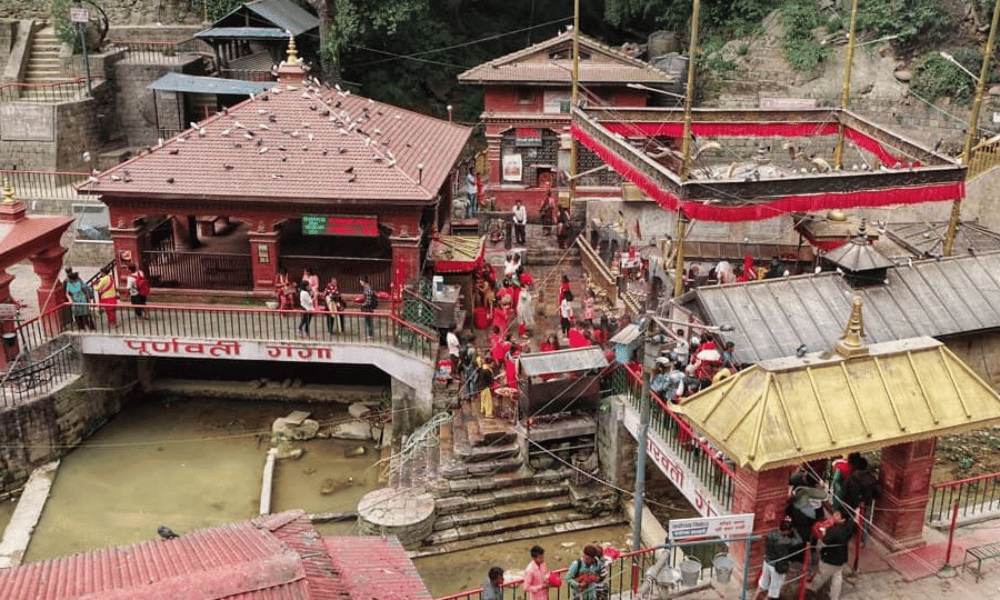
The Dakshinkali Temple, surrounded by lush forests, is a peaceful retreat from the hustle and bustle of Kathmandu. The temple complex contains additional shrines that are devoted to various gods. While discovering the historical significance of this ancient place, visitors can enjoy the peaceful environment of the surrounding area. Visitors can combine their visit to the temple with a beautiful drive through rural Nepal's stunning scenery due to its location on the outskirts of the Kathmandu Valley.
Dakshinkali Temple Facts
|
Site |
Dakshinkali |
|
Affiliation |
Hinduism |
|
Deity |
Goddess Kali |
|
Location |
Pharping, Kathmandu |
|
Established by |
N/A |
|
Major Attractions |
|
|
Major Celebrations |
|
|
Style |
Newari Style |
|
Opening Hours (main temple) |
06:00 AM–9:00 PM |
|
Entry Fee |
No Entry fee |
How to Reach?
Passing through the cities that are close by is a sensible option for travelers who are interested in visiting the Dakshinkali Temple.
From Kathmandu
To reach Dakshinkali Temple from Kathmandu, you can hire a taxi or rent a car for a comfortable journey. The distance from Kathmandu to Daksinkali is about 22 kilometers, which will take around 1 hours. Alternatively, you can take a public bus from Kathmandu's Kalanki Bus Park heading to Dakshinkali, and the bus will take you through the scenic route to the temple.
Patan Krishna Temple
The Patan Krishna Temple is a stunning religious site in the historic city of Patan in the Kathmandu Valley of Nepal. This historic temple dedicated to Lord Krishna was established in the 17th century by King Siddhinarasimh Malla. Its architecture is a stunning example of Newari craftsmanship and the peak of traditional Nepalese temple design. The three-tiered Shikhara Style structure of the temple is decorated with delicate wood carvings and decorative elements, including the 21 pinnacles, that highlight the extraordinary ability of the local craftsmen. The carvings on the first level pillar of this temple tell the story of the Mahabharata, while the second floor tells the story of the Ramayana in Newari writings.
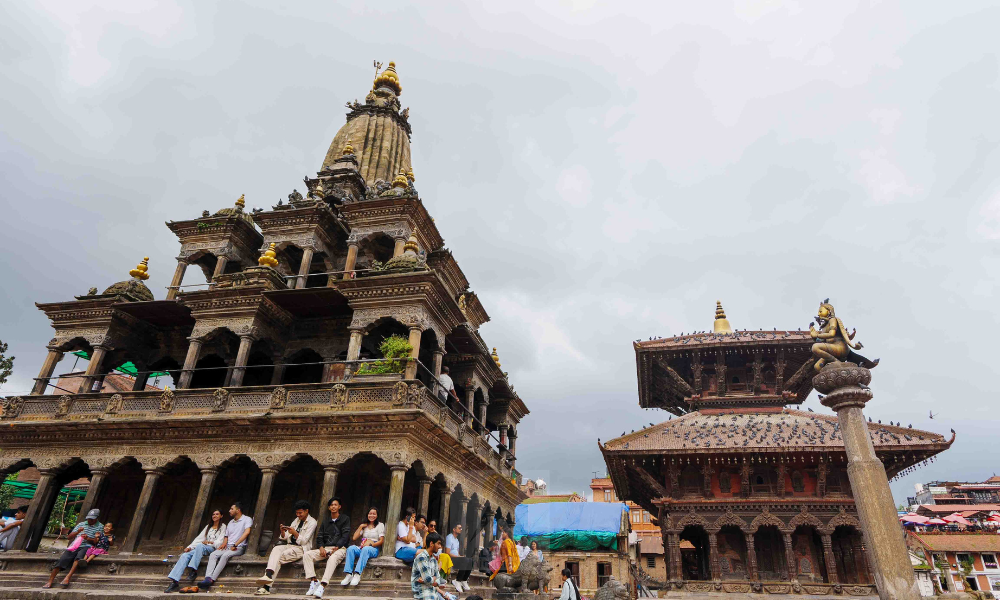
The first floor houses the shrines of Lord Krishna, Radha, and Rukmini. The second story is dedicated to Lord Shiva, while the third is dedicated to Lord Buddha. Therefore, this temple is significant both historically and religiously. The surrounding area is rich in history and culture, with various temples, palaces, and courtyards contributing to the city's UNESCO World Heritage Site status. Patan, also known as Lalitpur, is renowned for its well-preserved ancient architecture and strong artistic traditions,making the Krishna Temple a crucial component of this cultural tapestry.
The Patan Krishna Temple holds high significance for religious and cultural reasons. Devotees visit this temple to pay their respects to Lord Krishna, an important deity in Hinduism, and to take part in the temple's various religious events and festivals, which take place throughout the year. The main chamber of the temple has an idol of Lord Krishna, and the atmosphere is filled with the sound of ringing bells and devotional chants. Furthermore, the temple's courtyard frequently holds cultural events, dances, and music performances, providing visitors with an opportunity to immerse themselves in the colorful local culture. The Patan Krishna Temple's peaceful environment, architectural beauty, and spiritual aura make it a must-visit destination for pilgrims and tourists alike, providing a unique opportunity to witness Nepal's rich cultural legacy while exploring its spiritual origins.
Patan Krishna Temple Facts
|
Site |
Patan Krishna Temple |
|
Affiliation |
Hinduism |
|
Deity |
|
|
Location |
Patan, Lalitpur |
|
Established by |
King Siddhi Narasingh Malla |
|
Major Attractions |
|
|
Major Celebrations |
Krishna Janmastami |
|
Style |
Shikhara Style |
|
Area |
N/A |
|
Opening Hours (main temple) |
04:00 AM to 09:00 PM |
|
Entry Fee |
No Entry Fee |
How to reach?
One of the most time-efficient ways to get to Patan Krishna Temple is by way of the adjacent cities.
From Kathmandu
To reach Patan Krishna Temple from Kathmandu, you can take public transport, such as a local bus or microbus, heading towards Patan Durbar Square. Once you reach the square, the temple is a short walk away, and you can easily find it with the help of local directions or a map. The journey by public transport may take about 30-45 minutes, depending on traffic and the specific route of the bus.
Doleshwor Mahadev Temple
Doleshwor Mahadev Temple, located in Suryabinayak, Bhaktapur, is an important religious and cultural destination. This ancient temple is conveniently located near Kathmandu, the capital city of Nepal, making it accessible to both pilgrims and tourists. The temple has a rich history and mythology, dating back to the pages of the Hindu epic Ramayana. According to local legend, it is the sacred spot where Lord Shiva's head is said to have landed after being severed from his body following a great battle with the demon king Ravana. This mythological connection gives the temple a unique spiritual aura that draws pilgrims from different places.
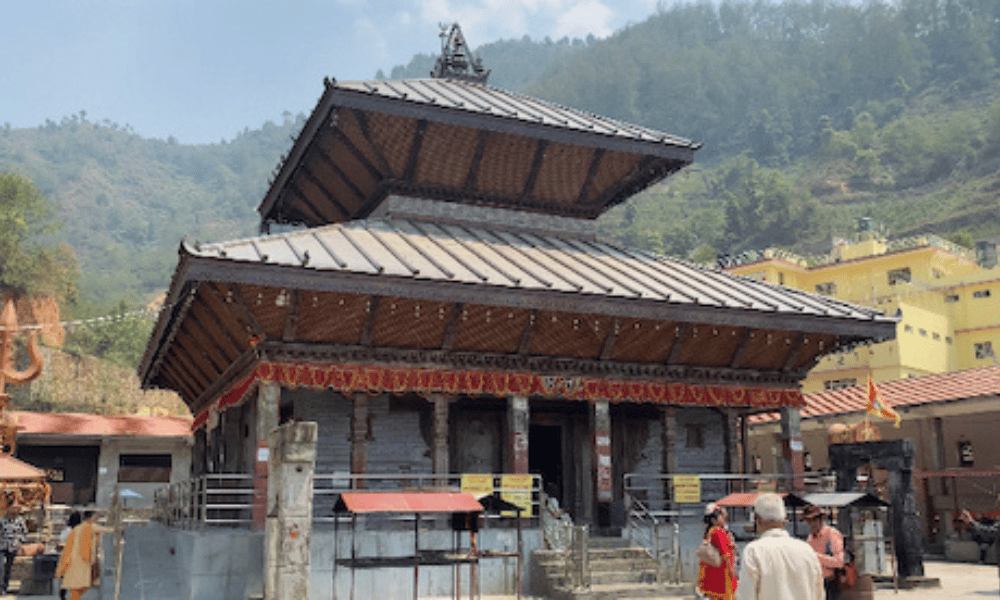
The architectural beauty of Doleshwor Mahadev Temple represents the ancient craftsmanship of the Newari people. Its architectural style is characterized by delicately carved wooden features, beautifully designed doors and windows, and the iconic pagoda-style roof, all of which add to its aesthetic glory. The temple's natural surroundings, which include lush hills and forests, enhance it by creating a serene atmosphere suitable for meditation and prayer. The temple complex also features a sacred pond where devotees can take ritual baths, which adds to the overall spiritual experience for tourists.
Doleshwor Mahadev Temple is regarded as a spiritual center for Hindus, particularly followers of Lord Shiva. Pilgrims come to this sacred spot to perform rituals, pray, and seek Lord Shiva's blessings. The temple is often the site of religious ceremonies and festivals, which adds to its cultural significance. Tourists are drawn to the temple not just for its religious significance but also for its architectural and natural beauty, making it a popular tourist destination in Nepal. Doleshwor Mahadev Temple's fusion of history, spirituality, and beauty makes it a must-visit destination for visitors interested in learning about Nepal's rich cultural heritage and religious traditions.
Doleshwor Mahadev Temple Facts
|
Site |
Doleshwor Mahadev |
|
Affiliation |
Hinduism |
|
Deity |
Shiva |
|
Location |
Suryabinayak, Bhaktapur |
|
Established by |
N/A |
|
Major Attractions |
|
|
Major Celebrations |
|
|
Style |
|
|
Opening Hours (main temple) |
05:30 AM - 07:00 PM |
|
Entry Fee |
No Entry Fee |
How to reach?
Going through the cities that are close by is one option for travelers who want to visit Doleshwor Mahadev Temple.
From Bhaktapur
To reach Doleshwor Mahadev Temple from Bhaktapur, head east on the Arniko Highway for approximately 10–12 kilometers until you reach Sipadol village. Follow local signs to the temple. The journey takes about 30-45 minutes by road. One can use the available public transportation or hire a vehicle for the journey.
Muktinath Temple
Muktinath Temple, in the Mustang district of Nepal, is a sacred pilgrimage place for both Hindus and Buddhists. Its unique location in the high Himalayas, at an elevation of approximately 3,800 meters (12,467 feet), adds to its appeal. The temple is located within the Annapurna Conservation Area and is surrounded by spectacular mountain panoramic views. It is frequently visited as part of the famous Annapurna Circuit trek.
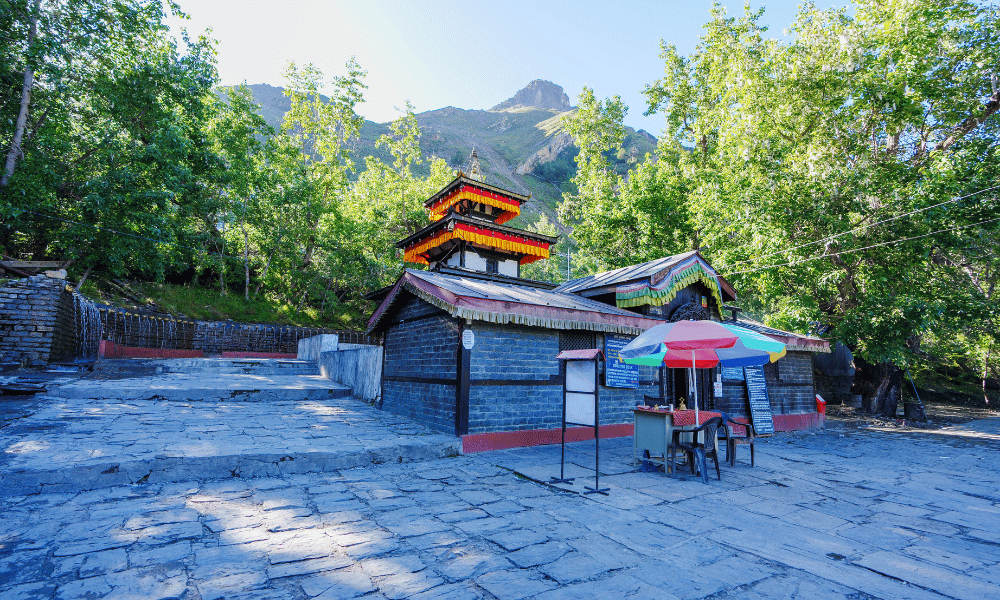
Muktinath Temple has a rich history and is mentioned in several Hindu scriptures. It is one of the 108 sacred Vishnu shrines, and the name "Muktinath'' translates to "place of salvation." Lord Vishnu, the god of liberation, is believed to reside in this temple as "Muktinath," according to Hindu beliefs. The temple is also significant for Buddhists, as it is believed to be a sacred site where the Buddhist sage Guru Rinpoche meditated during his journey to Tibet. The temple's architecture, which incorporates features from both religions, reflects the harmonious coexistence of Hindu and Buddhist traditions. The pagoda-style temple, with beautiful wood carvings and a golden pinnacle, reflects the region's architectural and religious diversity.
The Muktinath Temple is very important to people who come there to find spiritual freedom and blessings. Pilgrims believe that taking a holy bath in the 108 water spouts around the temple can cleanse their sins and bring them salvation. The temple complex includes a Buddhist gumba (monastery), highlighting the sacred site's multifaith nature. Aside from its religious significance, Muktinath also has natural attractions, such as the jaw-dropping views of the Mustang region and the nearby Jwala Mai Temple, which is known for its never-ending flame. These features make Muktinath a must-visit destination for those interested in experiencing the Himalayas' cultural, spiritual, and natural wealth.
Read More: Muktinath Temple | Muktinath Tour Package From India
Muktinath Temple Facts
|
Site |
Muktinath |
|
Affiliation |
|
|
Deity |
Lord Muktinath (Lord Vishnu) |
|
Location |
Mustang, Nepal |
|
Established by |
N/A |
|
Major Attractions |
|
|
Major Celebrations |
|
|
Style |
Pagoda Style |
|
Opening Hours (main temple) |
05:00 AM–12:00 PM 02:00 PM–09:00 PM |
|
Entry Fee |
No Entry Fee |
How to Reach?
One alternative for people who want to visit Muktinath Temple is to travel through nearby cities.
From Mustang
To reach Muktinath Temple from Mustang, you can hire a jeep or take a local bus. The journey by road typically takes around 2 to 4 hours, depending on road conditions. You will be traveling to the village of Ranipauwa, which is near Muktinath Temple. Once you arrive in Ranipauwa, you can easily walk to the temple complex.
Changu Narayan Temple
Changu Narayan Temple is a popular sacred Hindu temple situated on a hilltop in Changu Narayan, about 12 kilometers east of Kathmandu, Nepal. This historic temple is not only one of the oldest in the Kathmandu Valley, but it is also a UNESCO World Heritage Site, making it an important cultural and historical monument. The temple's location atop a hill offers tourists panoramic views of the surrounding valley and Himalayan mountains, adding to its visual appeal.

Changu Narayan Temple's history is rooted in mythology and dates back over a thousand years. It is believed to have been built in the fourth century during Licchavi King Haridatta Barma’s rule, making it one of Nepal's oldest Hindu temples. The temple is devoted to Lord Vishnu in his form as Narayan, the universe's preserver. The temple is famous for its exceptional wood and stone sculptures that display great craftsmanship and artistic details. The architecture of Changu Narayan Temple is distinguished by its pagoda-style design, two-tiered roof, and numerous sculptures and engravings portraying Hindu deities and scenes from Hindu mythology. The surrounding area is rich in history and culture, with beautiful forests, terraced fields, and ancient stone inscriptions.
Changu Narayan Temple is of immense religious and historical significance to Hindus in Nepal and around the globe. It is regarded as a sacred pilgrimage site and a center of devotion. Smaller shrines and courtyards are also part of the temple complex, each with its own distinct artistic and architectural aspects. Visitors are captivated by the beauty of the temple's sculptures and artwork, which showcase ancient Nepalese craftsmanship. Furthermore, Changu Narayan Temple is an excellent destination for history enthusiasts and those interested in learning about Nepal's rich cultural heritage. The temple's peaceful surroundings, combined with its historical and religious significance, make it a must-visit for anyone interested in Nepal's deep-rooted traditions and architectural treasures.
Read More: Changu Narayan Temple
Changu Narayan Temple Facts
|
Site |
Changu Narayan |
|
Affiliation |
Hinduism |
|
Deity |
Lord Vishnu |
|
Location |
Changu Narayan, Bhaktapur |
|
Established by |
Licchavi King Haridatta Barma |
|
Major Attractions |
|
|
Major Celebrations |
|
|
Style |
|
|
Opening Hours (main temple) |
04:00 AM–10:00 PM |
|
Entry Fee |
|
How to Reach?
Travelers who want to visit Changu Narayan Temple have the option of passing through nearby cities.
From Bhaktapur
You can take a cab or use the public transportation available from Bhaktapur to Changu Narayan Temple. The temple is located 5 kilometers northeast of Bhaktapur Durbar Square and takes 15-20 minutes to drive, depending on traffic. Taxis and public transportation are readily available in Bhaktapur, and you can easily hire one to transport you to Changu Narayan Temple.
Bindhyabasini Temple
Bindhyabasini Temple is a renowned Hindu temple situated in Pokhara, an attractive city in the Gandaki Province of Nepal. The name Bindhyabasini translates to "Bindhya," meaning incarnation of the goddess, and "Basini," meaning dweller of a place. This sacred shrine is devoted to the Hindu goddess Durga's manifestation, Bindhyabasini, who is regarded as the protector of Pokhara and its inhabitants. Many people come here to worship and make sacrifices in order to have their wishes come true. The stunning Annapurna and Machapuchare mountain ranges serve as the temple's backdrop, making it a place of both spiritual significance and breathtaking natural beauty.
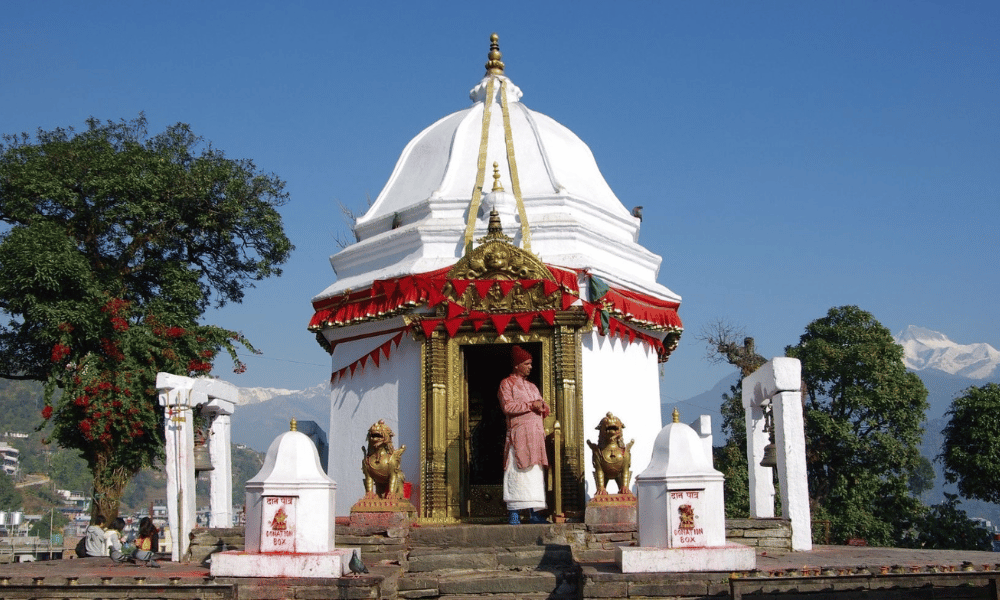
The origins of the Bindhyabasini Temple are rooted in ancient Hindu mythology and date back several centuries. It is said to have been established in the 17th century by King Siddhi Narayana Shah of the Kaski kingdom. With intricate wood and stone carvings adorning its structure, the temple's architecture reflects traditional Nepali shikhara design. The main shrine of the temple contains a sacred idol of Goddess Bindhyabasini, drawing pilgrims from all over Nepal and beyond.
The temple's role as a spiritual and cultural hub in Pokhara is one of its most significant features. Devotees come to offer prayers and seek the goddess's blessings, especially during festivals like Dashain and Tihar. The temple complex also includes a large area where numerous religious ceremonies and cultural events are held, creating a lively environment. The scenic location of Bindhyabasini Temple, with its panoramic views of the surrounding mountains and Pokhara Valley, also contributes to its popularity as a tourist destination. The unique blend of spirituality and natural beauty that defines this iconic religious site can be witnessed by visitors as they wander the temple grounds.
Read more: Bindhyabasini Temple
Bindhyabasini Temple Facts
|
Site |
Bindhyabasini |
|
Affilation |
Hinduism |
|
Deity |
Goddess Durga (Bhagwati) |
|
Location |
Pokhara, Nepal |
|
Established by |
Kaski King Siddhi Narayan Shah |
|
Major Attractions |
|
|
Major Celebrations |
|
|
Style |
Shikhara Style |
|
Opening Hours (main temple) |
24 hours |
|
Entry Fee |
No Entry Fee |
How to Reach?
Travelers who are interested in visiting Bindhyabasini Temple have the option of going through the cities that are located in close proximity to the temple.
From Pokhara
Pokhara to Bindhyabasini Temple is a scenic drive or taxi ride. The temple lies on a small hill 20 minutes from Pokhara's lakeside. If you want a more adventurous approach, you can trek up to the temple from Lakeside in 45 minutes to an hour.
Manakamana Temple
Manakamana Temple, located in Nepal's scenic hills, is a well-known Hindu pilgrimage site known for its breathtaking location, rich history, and unique cable car transportation. The temple is located in the Gorkha district, about 105 kilometers northwest of Kathmandu, on a hill in Kurintar. Manakamana is derived from two words 'mana' which means heart, and 'kamana', which means wish. It is a common belief in Manakamana that one's heartfelt wish is certain to come true.
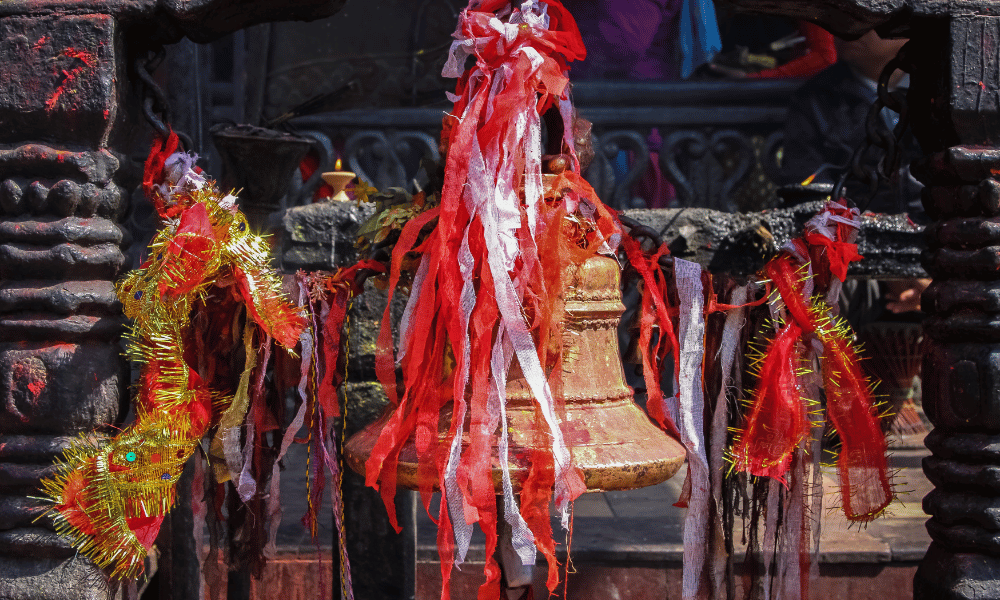
The origins of Manakamana Temple are shrouded in legend and date back several centuries. According to legend, the temple's deity, Goddess Bhagwati, appeared in a devotee's dream and instructed him to build a temple on a hill in her honor. The temple was built, and it has since become a place of deep spiritual significance. The temple is built in the traditional Nepali pagoda style, with intricate wood carvings and sculptures. Its calm surroundings offer panoramic views of the Himalayan mountains and lush green valleys, enhancing the overall pilgrimage and visitor experience.
Manakamana Temple's significance extends beyond its religious significance. Devotees come to this sacred site to seek Goddess Bhagwati's blessings and to pray for their wishes and desires to be granted. The temple draws both Nepali and international tourists, who are drawn not only by its religious significance but also by the adventure of reaching the temple. To get to the temple, visitors must take a thrilling cable car ride across the rugged terrain, which provides breathtaking views of the landscape. The journey to the temple is an attraction in and of itself, and the temple complex includes a variety of shops and eateries for visitors to enjoy. Manakamana Temple is a must-visit place in Nepal because of its harmonious blend of spirituality, natural beauty, and cultural experience.
Read More: Manakamana Temple | Cable Cars In Nepal
Manakamana Temple Facts
|
Site |
Manakamana |
|
Affiliation |
Hinduism |
|
Deity |
Goddess Durga (Bhagwati) |
|
Location |
Kurintar, Gorkha |
|
Established by |
N/A |
|
Major Attractions |
|
|
Major Celebrations |
|
|
Style |
Pagoda Style |
|
Opening Hours (main temple) |
05:00 AM - 12:00 PM 02:00 PM- 09:00 PM |
|
Entry Fee |
No Entry Fee |
How to Reach?
One route that people who want to visit the Manakamana Temple can take is through nearby cities.
From Kathmandu
Take a scenic drive or rent a private vehicle to reach Manakamana Temple from Kathmandu, 105 kilometers northwest, in 3–4 hours. You can also take a bus from Kathmandu's Gongabu Bus Park to Kurintar, the Manakamana Cable Car's base. An exciting cable car ride from Kurintar takes you to the temple's hilltop, with stunning views of the hills and valleys.
Jal Narayan Temple
Jal Narayan Temple, also known as Budhanilkantha Temple, is a significant Hindu temple in Nepal's Kathmandu Valley. Buddhists, who believe the murti to be Buddha, also highly revere this temple, which Hindus also regard as a sacred space. It is considered a sign of religious harmony that has existed in the region since ancient times. This temple, located approximately 10 kilometers north of Kathmandu, is a famous religious and cultural landmark. The fact that the temple is in the peaceful and beautiful Shivapuri Nagarjun National Park adds to its charm and makes it a quick getaway from the busy city of Kathmandu.

Jal Narayan Temple's history is deeply rooted in Hindu myths and legends. The temple is dedicated to Lord Vishnu and is renowned for its enormous stone statue of the god resting on Sheshnaag, a coiled serpent that miraculously floats in the resting pond. This magnificent image of Lord Vishnu, believed to have been carved during the Licchavi period in the seventh century, is a masterpiece of ancient Nepalese stone sculpture. Due to the blue color of Lord Vishnu's statue's throat, the name of the temple, "Budhanilkantha," is derived from the Newari language and refers to the deity as "Blue-throated."
The Jal Narayan temple is an excellent example of traditional Nepalese craftsmanship. The main structure of the temple is constructed in pagoda style, with intricate wooden carvings decorating its outer walls and supporting structures. The temple's location is equally stunning, nestled in a peaceful pond and surrounded by lush gardens and forest-covered hills. Devotees and visitors can navigate around the sacred pond and pay homage to the deity while taking in the area's natural beauty. A large number of pilgrims and visitors are drawn to the temple not only by its religious significance but also by its architectural beauty and peaceful surroundings. The temple also hosts religious and cultural celebrations, such as Haribodhini Ekadashi, to enrich the experience of visitors and showcase Nepal's diverse heritage.
Read More: Budhanilkantha Temple
Jal Narayan Temple Facts
|
Site |
Jal Narayan / Budhanilkantha |
|
Affilation |
Hinduism |
|
Deity |
|
|
Location |
Budhanilkantha, Kathmandu |
|
Established by |
N/A |
|
Major Attractions |
|
|
Major Celebrations |
|
|
Style |
Pagoda Style |
|
Opening Hours (main temple) |
04:00 AM - 07:30 PM |
|
Entry Fee |
No Entry Fee |
How to reach?
Travelers who are interested in visiting Jal Narayan Temple have the option of going through the cities that are located in close proximity to the temple.
From Kathmandu
To reach Jal Narayan Temple from Kathmandu, take a taxi or local bus heading to Budhanilkantha. It's approximately 10 kilometers north of the Kathmandu city center. The journey takes about 30 minutes by taxi or slightly longer by bus. Once in Budhanilkantha, it's a short walk to the temple.
Conclusion
Taking a tour of Nepal's 12 must visit Hindu temples is a captivating journey that combines spiritual devotion with breathtaking architectural beauty. The temples are more than just places of worship; they are living evidence of the country's rich religious traditions, culture, and history. From the renowned Pashupatinath Temple, where the sacred Bagmati River runs, to the breattaking ride to Manakamana Temple, Nepal's temples give pilgrims and vacationers alike a unique and deep experience.
As we've learned more about Nepal's numerous temples, it's become clear that each one has its own story, a sacred energy, and a sense of calm that connects people to the divine. Whether in Kathmandu's busy Durbar Squares, Muktinath's peaceful surroundings, or Badimalika's spiritual aura, Nepal's temples attract visitors to explore their spiritual and cultural significance. They serve as everlasting testaments to a country's enduring faith and legacy, making Nepal a genuinely captivating destination for people seeking both spiritual awakening and breathtaking beauty.

